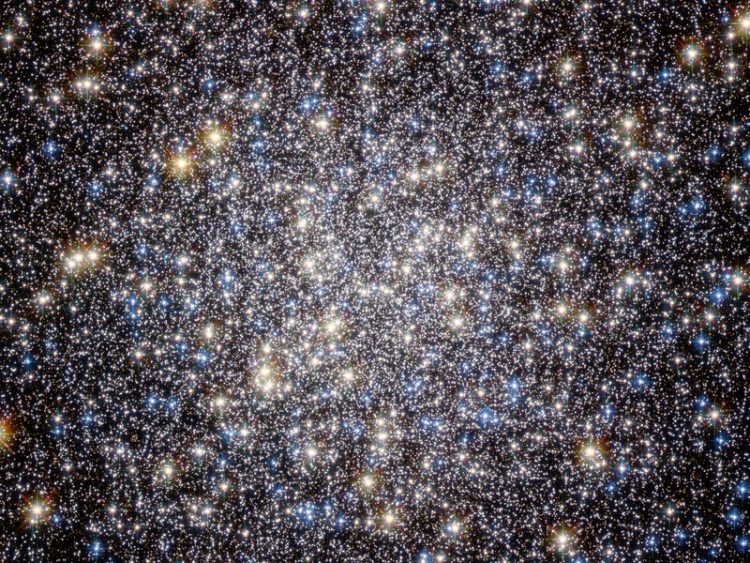Rotating globular clusters

The core of the globular cluster Messier 13 is just 25 000 light-years away and measures about 145 light-years in diameter. It lies in the constellation Hercules and sometimes can even be seen with small binoculars. Credit: ESA / Hubble und NASA
This finding is very surprising, as the astronomers expected that any central rotation should have been erased by now due to the old age of these clusters.
In addition, the astronomers from the Max Planck Institute for Extraterrestrial Physics and the University of Texas found that the rotation axis agrees with the slight elongation found for some of the clusters, indicating that this flattening is caused by rotation.
Globular clusters are ancient formations orbiting most galaxies, including our own Milky Way: they consist of up to a million old, metal-poor stars, which are tightly bound by gravity. Due to their old age and fairly spherical shape, with a strong concentration of stars towards the centre, they have historically been viewed as simple systems. However, new observations keep revealing surprising results.
“For all globular clusters in our sample we find a rotation signal in the centre – an astonishing result,” says Maximilian Fabricius, lead scientists of this study at the Max Planck Institute for Extraterrestrial Physics (MPE). “We did not expect this; originally we observed these globular clusters to measure their central velocity dispersions.” The velocity dispersion is a measure of the amount of random stellar motion in a cluster. Rotation, on the other hand, means that the cluster has an actual rotation axis around which more stars revolve in one way than the other.
“Theory and numerical simulations of globular clusters indicate that any central rotation should be erased on relatively short timescales,” says Eva Noyola, co-author of this study at the University of Texas in Austin. “Because these globular clusters were formed billions of years ago, we would expect that any rotation signature would have been eradicated by now. Even though previous measurements showed some rotation in a handful of systems, they only probed the motion of stars in the outer regions.”
The new measurements of a dozen globular cluster cores were only possible with the help of the VIRUS-W instrument developed at MPE. This “integral field spectrograph” (IFU) allows the scientists to simultaneously measure more than 260 spectra in their field of view, determining the motion of stars to an accuracy of a few kilometres per second. That means that for a given globular cluster, one night at the Harlan J. Smith 2.7m Telescope of the McDonald observatory in Texas with an observing time of a few hours is enough to determine the velocity field at the core of the cluster. Such a project was not possible before VIRUS-W.
Traditionally, astronomers determined the line-of-sight velocities of cluster member stars one-by-one using high resolution spectrographs that can measure the Doppler shift of the stars. This, however, is painstakingly slow and very hard to do in the core of globular clusters. Therefore, so far, there have been no systematic studies of the kinematics of globular cluster cores. Even though the VIRUS-W instrument was originally developed to study the kinematics of nearby galaxies, the astronomers realized that the combination of a large field of view and a relatively high spectral resolution make this instrument a very efficient tool to also study stellar motions in globular clusters.
There are about 150 globular clusters in the Milky Way and the astronomers selected 27 of them, which are observable with the McDonald telescope (i.e. in the northern sky) during one night. Between August 2012 and August 2013 they observed the first 11 globular clusters and now present their surprising results: all clusters show signatures of rotation.
Furthermore, the new velocity measurements are actually in remarkably good agreement with the flattening measured for the globular clusters in this sample. This seems to indicate that the central rotation drives the flattening for these objects rather than the influence of the Milky Way tidal field.
These findings raise interesting questions about the formation history and evolution of globular clusters – none of the current theoretical models predict such a ubiquitous and strong rotation. However, it is worth noting that the present sub-sample does not include any “core-collapsed” globular clusters yet.
Core-collapse is a process that might eradicate rotation. Future observations of the remaining clusters in the full sample will shed light on additional questions such as a possible correlation between rotation and the position of a globular cluster inside our galaxy.
Contact
Dr. Hannelore Hämmerle
MPE Pressesprecherin
Max-Planck-Institut für extraterrestrische Physik, Garching
Maximilian Fabricius
Optische und interpretative Astronomie
Max-Planck-Institut für extraterrestrische Physik, Garching
Media Contact
More Information:
http://www.mpe.mpg.de/5872915/News_20140507All latest news from the category: Physics and Astronomy
This area deals with the fundamental laws and building blocks of nature and how they interact, the properties and the behavior of matter, and research into space and time and their structures.
innovations-report provides in-depth reports and articles on subjects such as astrophysics, laser technologies, nuclear, quantum, particle and solid-state physics, nanotechnologies, planetary research and findings (Mars, Venus) and developments related to the Hubble Telescope.
Newest articles

Sea slugs inspire highly stretchable biomedical sensor
USC Viterbi School of Engineering researcher Hangbo Zhao presents findings on highly stretchable and customizable microneedles for application in fields including neuroscience, tissue engineering, and wearable bioelectronics. The revolution in…

Twisting and binding matter waves with photons in a cavity
Precisely measuring the energy states of individual atoms has been a historical challenge for physicists due to atomic recoil. When an atom interacts with a photon, the atom “recoils” in…

Nanotubes, nanoparticles, and antibodies detect tiny amounts of fentanyl
New sensor is six orders of magnitude more sensitive than the next best thing. A research team at Pitt led by Alexander Star, a chemistry professor in the Kenneth P. Dietrich…





















